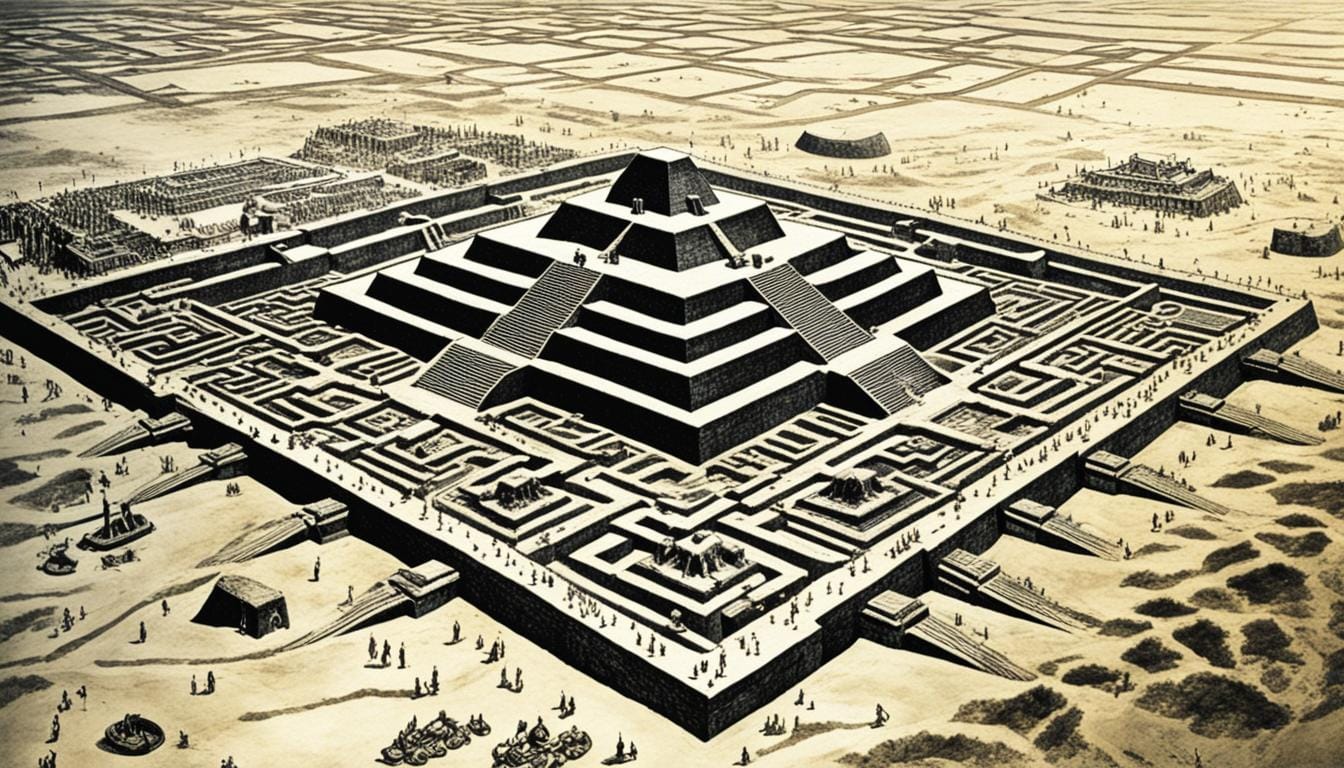Ancient history is full of unsolved mysteries. Some, like lost burial sites and sunken cities, have fascinated people for centuries. These enigmas still stump experts today, testing our grasp of the past.
Thanks to new archaeological technologies, researchers have found more clues. Yet, many mysteries stay unclear. This piece looks at 10 of the most intriguing historical enigmas that have stumped scholars for years.
Unsolved Mysteries from Ancient History
Ancient history is full of mysteries that have intrigued people for centuries. These ancient enigmas and historical riddles still puzzle experts today. They try to understand the secrets of old times.
Captivating Unsolved Riddles and Origins
The Terracotta Army is a big mystery. It’s a group of over 8,000 life-sized statues found near a Chinese emperor’s tomb. People are still trying to figure out why these statues were made and how the ancient Chinese did it.
The story of Atlantis is another big mystery. This lost city was talked about by an ancient Greek philosopher. It’s thought to have been around 9,000 years before our time. People are still wondering if it really existed and what it was like.
Advancements in Archaeological Technologies
New technology has helped solve some of these ancient mysteries. Tools like ground-penetrating radar and chemical analysis have found new clues. They’ve given us a better look at unexplained historical events and lost civilizations.
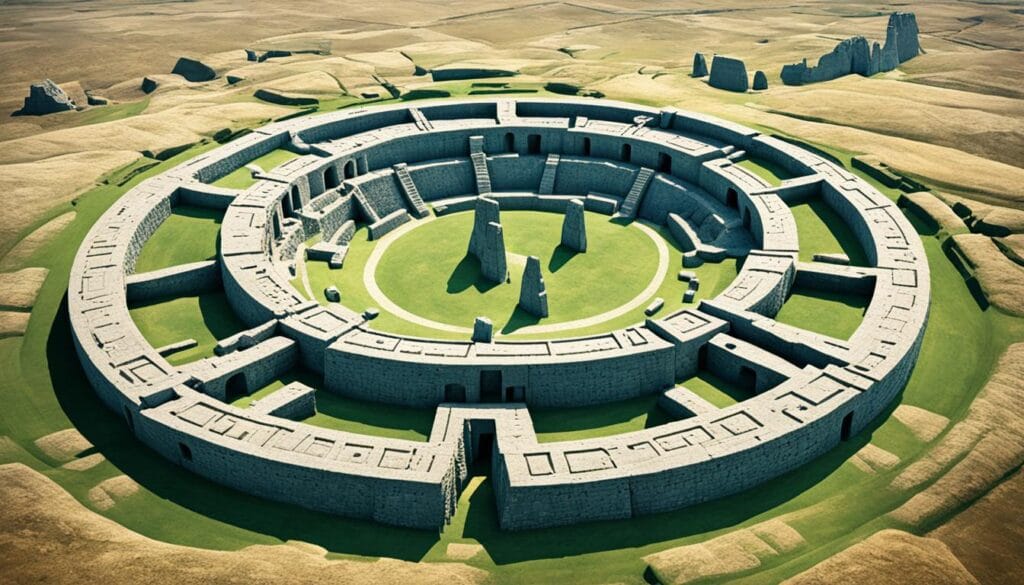
People are still very interested in these unsolved riddles and archaeological puzzles. The mystery of the past keeps drawing us in. It makes us want to learn more about ancient enigmas.
Thonis-Heracleion: The Real-Life Atlantis
Thonis-Heracleion was an ancient Egyptian port city on the Mediterranean Sea. It was a key trading spot before it sank around the second century B.C. Rediscovered in the early 2000s, it has given us many artifacts like statues, animal sarcophagi, and temple ruins.
These artifacts also include pottery shards, jewelry, coins, and even 2,400-year-old fruit baskets. The city sank likely due to soil liquefaction from natural disasters. This has given researchers a peek into the past, revealing much about this lost civilization.
Research on Thonis-Heracleion started in 1996, with the first discoveries in 2000. It’s about 6.5 kilometers off the coast in Aboukir Bay, at a depth of 10 meters. The city was most alive from the 6th to the 4th century BC. So far, only 5 percent of it has been found.
Excavations have found many coins and ceramics from its peak times. They also found a grand canal that went from east to west, linking the port with a lake. The city had a big ceremony for the Mysteries of Osiris every year.
In July 2022, archaeologists found a big temple dedicated to Amun, the Egyptian god. This temple was part of the city’s rich history.
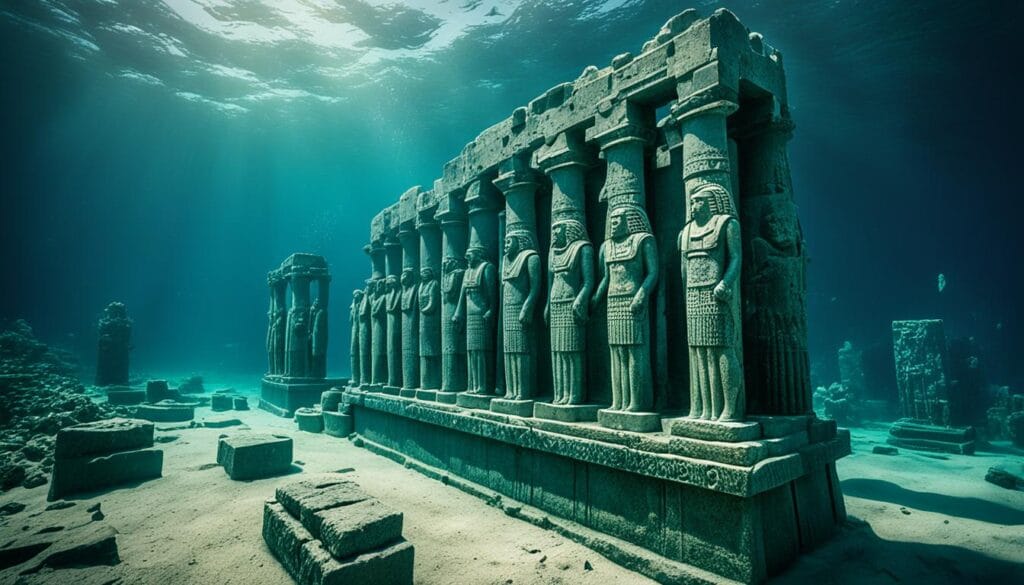
Thonis-Heracleion, an “Egyptian Atlantis,” sank over 1,000 years ago. Founded in the 8th century BC, it was Egypt’s biggest port before Alexandria was built in 331 BC. Recent digs have uncovered ancient mysteries and mythical artifacts, showing us the history of this sunken city and the underwater archaeology that’s still uncovering its secrets.
Plain of Jars: Ancient Stone Urns
In northern Laos, the Plain of Jars is a place of mystery. It has thousands of stone relics from the Iron Age. These jars, some as tall as 10 feet and weighing tons, intrigue experts and historians. Legends say giants used them as wine glasses, but their true purpose is still unknown.
Iron Age Relics Shrouded in Mystery
Archaeologists have been studying these ancient jars. They found that some jars might be over 3,000 years old. This is even older than the human remains found nearby.
Many theories exist about the jars. Some think they were for funerals, others for storing water, or part of a trade network for salt. But, the real reason behind these jars is still a mystery.
- The Plain of Jars in Laos is home to at least 3,000 giant stone jars, up to three meters tall.
- Recent studies suggest some jars could be over 3,000 years old.
- Human burials were found near the jars, dating from 700 to 1,200 years ago.
- Over 60% of the human remains found were infants or babies.
Researchers are still trying to solve the mysteries of the Plain of Jars. These ancient relics from the Iron Age keep captivating us. They might hold secrets about past societies and rituals, keeping historians and archaeologists curious.

Guanabara Bay: Roman Presence in Brazil?
Exploring ancient sea journeys and possible contacts across oceans has always intrigued historians and archaeologists. The mystery of Roman artifacts in Brazil’s Guanabara Bay is a prime example. If true, it would change how we see world history.
In 1982, Robert Marx, a famous shipwreck hunter, said he found Roman amphoras in Guanabara Bay. These vases, if real, would show Romans were in Brazil over a thousand years before the Portuguese. But, the Brazilian government stopped further research, accusing Marx of looting.
Today, whether the Roman artifacts are real is still up in the air. Some doubt they’re ancient, thinking they might be from modern ships or just ballast. Others believe they’re proof of a Roman trip to Brazil before Columbus.
| Year | Discovery | Significance |
|---|---|---|
| 1982 | Robert Marx reports finding Roman amphoras in Guanabara Bay, Brazil | Potential evidence of a Roman presence in the Americas over 1,000 years before the Portuguese |
| 1982 | Brazilian government bans further exploration of the site | Accusations of looting against Marx, authenticity of artifacts remains unconfirmed |
| Present | Debate continues over the Roman artifacts and their implications for ancient history | Unresolved mystery of a possible ancient European presence in Brazil |
If the Guanabara Bay discovery is true, it would be a big deal for understanding ancient sea travel and world history. It could reveal new things about historical enigmas, ancient mysteries, and controversial history related to historical conspiracies and ancient relics. But, we need solid proof before we can say for sure.

Nazca Lines: Enigmatic Geoglyphs
About 2,000 years ago, a pre-Inca group made huge ancient drawings and ancient symbols in Peru. These geoglyphs include long lines up to 30 miles and detailed animals and plants. They have been a mystery for a long time.
Unexplained Ancient Drawings and Symbols
Some think the Nazca Lines were for water rituals. But, we still don’t know for sure why they made these enigmatic ancient drawings. New discoveries keep adding to the mystery of these unexplained historical events.
The Nasca people made the Nazca Lines almost two thousand years ago. They lived there for about 800 years, starting in 200 B.C. Scientists believe the lines were made between 200 B.C. and 600 A.D.
The Nazca desert is very dry, which helped keep the lines safe for 2,000 years. In 2019, a team from Japan found 143 new figures. These included birds, monkeys, snakes, and foxes.
| Nazca Lines Key Facts | Details |
|---|---|
| Creation Period | 200 B.C. to 600 A.D. |
| Geographical Area | Approximately 450 km2 in the Peruvian coastal plain |
| Geoglyphs Discovered | Thousands of large-scale zoomorphic and anthropomorphic figures and lines |
| UNESCO World Heritage Site | Recognized for its cultural significance |
The Nazca Lines and Geoglyphs cover about 450 km2 in Peru. They show a shared belief and social unity for nearly 2,000 years. These ancient enigmas still fascinate everyone, as their true meaning is still a mystery.
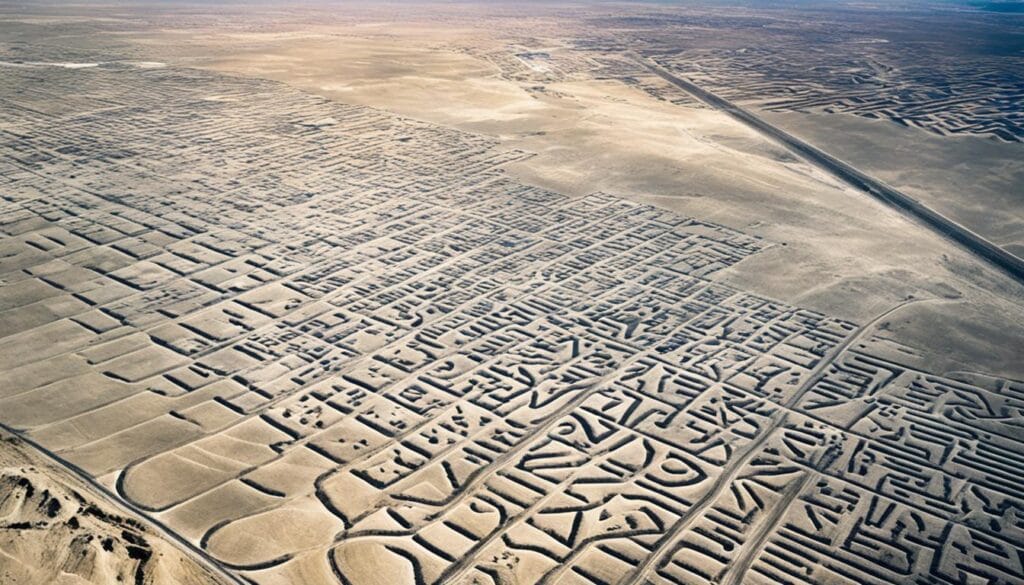
Paracas Candelabra: Massive Hillside Carving
Carved into a hillside overlooking Peru’s Pisco Bay, the Paracas Candelabra stretches 595 – 800 feet from top to bottom. It’s a massive geoglyph that has puzzled researchers for years. The pottery found there dates back to around 200 B.C., but the true age and purpose of the carving are still unknown.
The Paracas Candelabra was made by cutting deep trenches into hardened soil and placing rocks around the figure. It’s believed to have been built around 200 BCE, during the Paracas civilization in Peru’s Ica Region. Some think it might even be older.
Many theories exist about what the Paracas Candelabra means. Some believe it was a tool for ancient sailors or a symbol of the creator god Viracocha’s trident. Others think it was a signal for visitors to the Paracas coast. Yet, the true purpose of this enigmatic ancient drawing remains a mystery, leaving historians and archaeologists to keep guessing.
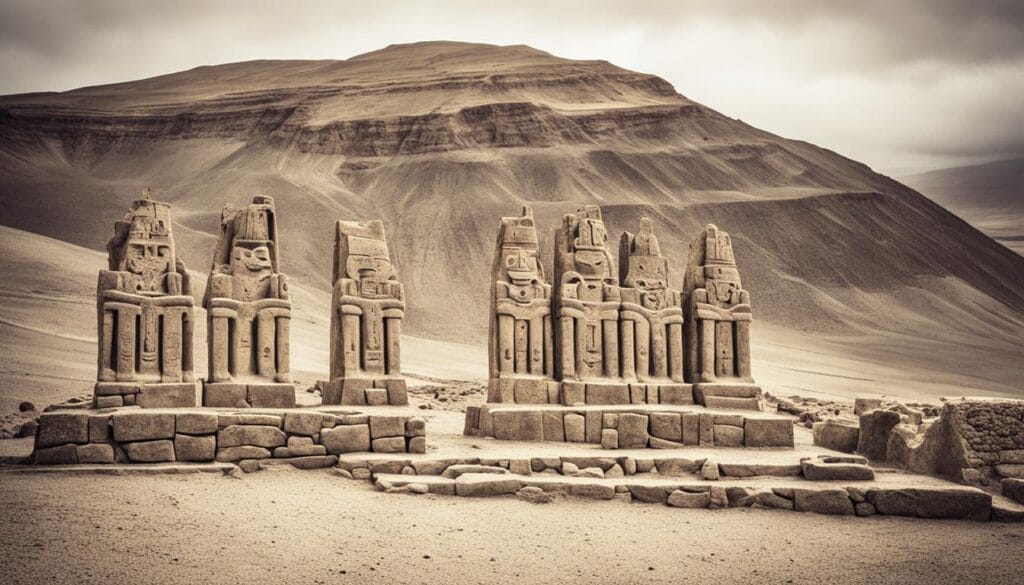
Peru is home to more than just the Paracas Candelabra. The Palpa lines, older than the Nazca Lines, feature over 600 giant drawings. In the American Southwest, over 300 intaglios (ground drawings) have been found. These discoveries show the deep archaeological puzzles left by ancient cultures.
Even after thousands of years, the Paracas Candelabra and similar unexplained historical events still intrigue us. They remind us of the ancient enigmas waiting to be solved.
Sacsayhuamán: Inca Engineering Marvel
The Sacsayhuamán fortress is near Cuzco, Peru. It shows the Inca’s amazing ancient engineering skills. Built in the 15th century, it has huge rocks, some over 125 tons, that fit together perfectly without mortar. The Inca used bronze and stone tools for this, showing their advanced ancient construction techniques.
Even when the Spanish tried to destroy it, Sacsayhuamán stayed strong. It survived big earthquakes and time, amazing everyone. In 1983, it became a UNESCO World Heritage Site. This shows it’s a key archaeological marvel and proves the smartness of the lost civilizations in the Andes.
Precisely Constructed with Bronze and Stone Tools
The Inca’s work at Sacsayhuamán is amazing. They built the walls using Inca architecture and ancient construction techniques. The stones were cut and fitted together so well, not even a piece of paper can slide through the gaps. This shows their top-notch masonry skills.
Today, tech like LiDAR is helping us learn more about Sacsayhuamán’s engineering. Archaeologists and historians are amazed by the Inca’s ancient engineering skills. The site’s design and construction make it a true engineering marvel of the ancient world.
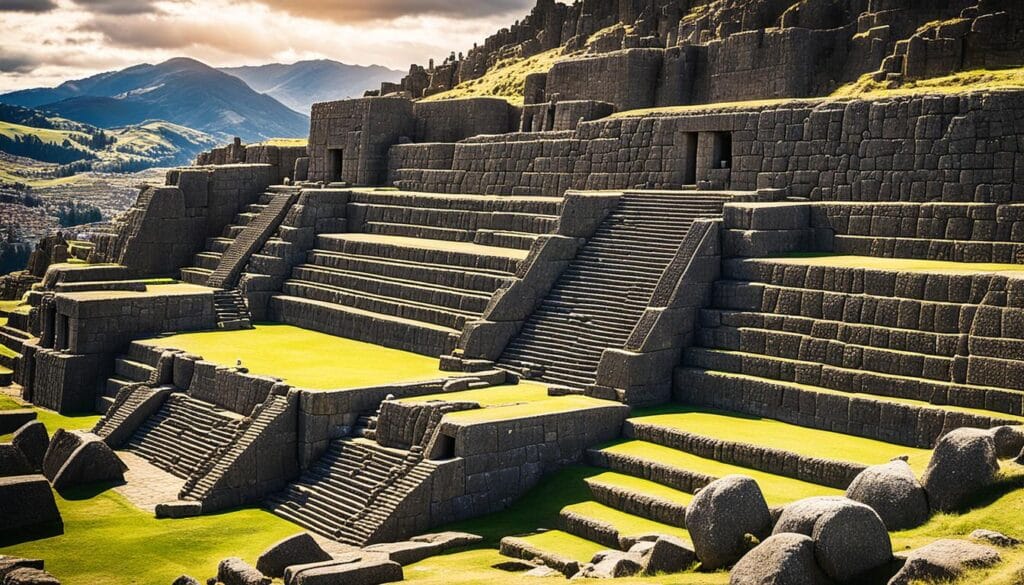
Historical Enigmas
History is full of mysteries that have captured our imaginations. These puzzles range from the disappearance of ancient civilizations to the secrets of mysterious artifacts. They keep us guessing and spark our curiosity.
The Mary Celeste, a merchant ship, was found empty in 1872. No one knows what happened to its 10 passengers and crew. Some think it was a leak or a storm, but we still don’t know for sure.
The Voynich Manuscript is another mystery. It’s a book from the 1400s with strange writing and pictures. People have tried to figure it out, but it’s still a secret.
Then there’s Peking Man, an ancient human found in 1923. His bones are missing, leaving us with more questions than answers.
The search for Alexander the Great’s tomb is another big mystery. Some believe it’s hidden in Alexandria, but it’s hard to find because of natural and human changes.
Other mysteries include the Nazca Lines in Peru and the identity of Jack the Ripper. These mysteries keep us talking and researching. With new technology, we might find answers soon.
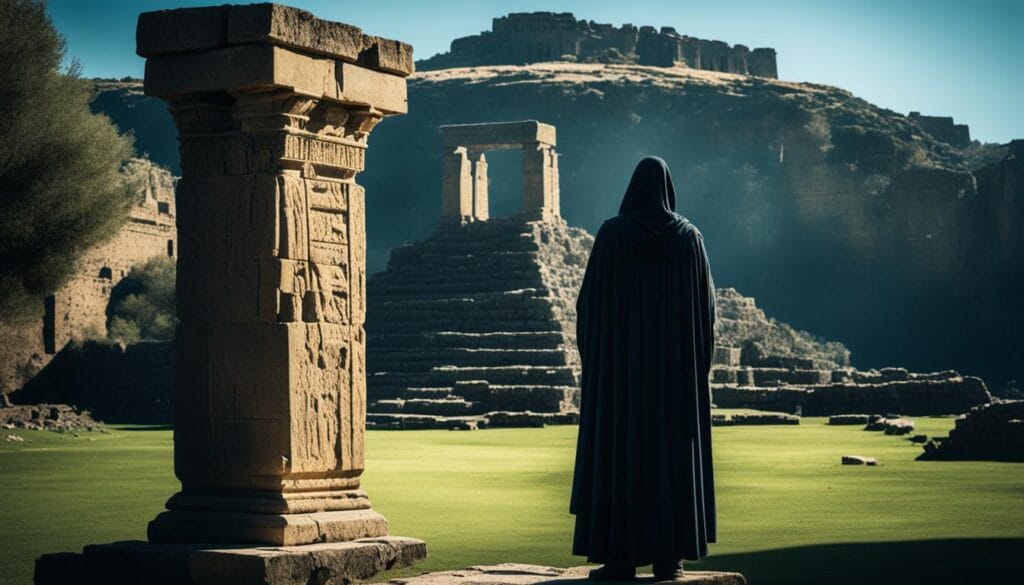
Questions like the Roanoke colonists’ disappearance and Captain William Kidd’s treasure keep us intrigued. They remind us that the past is full of secrets still waiting to be discovered.
Cleopatra’s Tomb: Lost Burial Site
The final resting place of Queen Cleopatra VII, the last ruler of ancient Egypt, is a mystery. For centuries, the historical riddle of where she and Mark Antony were buried has puzzled experts. Despite knowing a lot about her life, finding their lost burial site is still a challenge.
Some think Cleopatra’s tomb might have been in Alexandria, her capital, but it was lost in a 365 A.D. tsunami. Others believe it could be in the Nile Delta, in a temple for Isis and Osiris. The mystery of where this famous ancient ruler was buried has sparked many theories and historical conspiracies about her and Antony’s legendary artifacts.
Now, Egyptologist Zahi Hawass and Dominican archaeologist Kathleen Martinez are leading the search for Cleopatra’s lost burial site. New tech like ground-penetrating radar (GPR) and LiDAR is helping them. These tools give them hope of solving this long-standing ancient enigma.
The Elusive Final Resting Place of an Ancient Ruler
For almost 2,000 years, finding Cleopatra’s tomb has been a quest for historians and fans. Ancient writers like Plutarch gave hints, but the burial site‘s exact spot is still unknown. Even with discoveries at the Taposiris Magna temple in Alexandria, experts are unsure if they’ll find Antony and Cleopatra’s tomb there.
Then, a 1,305-meter tunnel was found under an Egyptian temple in 2022. This could be a big step towards finding Cleopatra’s tomb, bringing new hope. The mystery of this ancient enigma and the chance to learn about her legendary artifacts keeps everyone interested.

Voynich Manuscript: Indecipherable Medieval Codex
The Voynich Manuscript was bought by Wilfrid Voynich in 1912. It is a big puzzle from the medieval times. It has strange pictures of plants and naked women, making it hard to understand.
Many experts, like Alan Turing and the FBI, have tried to figure it out. But, the Voynich Manuscript is still a mystery. It’s a special kind of puzzle that keeps scholars guessing.
The story of the manuscript is also a mystery. Emperor Rudolph II of Germany paid a lot for it, thinking it was by Roger Bacon. Now, it’s at Yale University, still making people wonder.
| Key Facts about the Voynich Manuscript |
|---|
| – Rediscovered in 1912 by rare books dealer Wilfrid Voynich |
| – Purchased by Emperor Rudolph II of Germany for 600 gold ducats |
| – Believed to be the work of Roger Bacon |
| – Donated to the Beinecke Library in 1969 |
| – Contains drawings of 113 unidentified plant species |
| – Includes illustrations of miniature female nudes and medicinal herbs |
| – Radiocarbon dated to the early 15th century (1404-1438) |
| – Never been successfully deciphered despite numerous attempts |
The Voynich Manuscript is a big mystery from the medieval times. It has puzzles that scholars and the public find fascinating. Its secrets might always stay hidden, leaving us to imagine what it could mean.
Yonaguni Monument: Japan’s Atlantis?
Off Japan’s Yonaguni Island coast lies a mysterious underwater rock structure. It’s about 165 feet long, 65 feet wide, and 25 meters tall. Many call it a “Japanese Atlantis,” an ancient lost city hidden under the sea.
A diver found it in 1986. The Yonaguni Monument has stepped terraces and sharp corners like a man-made pyramid. This has sparked a big debate. Some think it’s from an old, advanced culture. Others believe it’s just a natural rock formation made by the sea.
Underwater Rock Formation or Ancient Ruins?
Marine geologist Masaaki Kimura has studied it for 20 years. He thinks it’s an ancient city’s ruins, about 10,000 years old. Kimura found tools, pottery, and fireplaces that might be made by humans.
But, Professor Robert Schoch from Boston University has a different view. He says it’s a mix of nature and human work, shaped by the sea and earthquakes. Japan is near the “Ring of Fire,” so it’s prone to earthquakes and volcanoes. This could explain the monument’s unique look.
The debate on the Yonaguni Monument’s origins is still going. It’s a mystery in the areas of historical enigmas, underwater archaeology, and lost civilizations and ancient ruins.
| Key Facts About the Yonaguni Monument | Values |
|---|---|
| Monument Height | 25 meters (82 feet) |
| Monument Length | 100 meters (328 feet) |
| Monument Width | 60 meters (197 feet) |
| Total Area Covered | 45,000 square meters |
| Estimated Age of Sandstone/Mudstone | 20 million years |
| Estimated Age of Monument (per Kimura) | 10,000 years |
Stonehenge: Purpose and Origins
Stonehenge is a famous prehistoric landmark that has puzzled experts for years. It started being built about 5,000 years ago, long before England used bronze. Today, we know it was a place for burials, but its deeper meanings are still a mystery.
Building Stonehenge took a huge effort, over 20 million hours. It was built in stages, with the first phase starting around 4,600 years ago. Later, stones from Wales, some over 145 miles away, were brought here. Finally, even bigger stones were added, creating the famous design we see today.
Despite lots of research, we still don’t fully understand Stonehenge. Some think it was for worshipping ancestors, others believe it had to do with the stars or healing. The Stonehenge Riverside Project is still uncovering its secrets, keeping its allure alive.
| Key Facts about Stonehenge | Details |
|---|---|
| Age | Approximately 4,600 years old |
| Construction Timeline | Built in several phases over thousands of years, starting around 5,000 years ago |
| Bluestones | Around 80 non-indigenous bluestones weighing up to 4 tons each, transported from Wales |
| Sarsen Stones | Over 50 sarsen stones, each weighing around 25 tons, added during the third phase |
| Largest Stone | The largest sarsen stone stands 24 feet tall and weighs more than 40 tons |
| Annual Visitors | Stonehenge attracts over 800,000 tourists annually, making it one of the most visited sites in the world |
Stonehenge’s mystery and its status as a UNESCO site keep drawing in researchers and tourists. It remains a fascinating topic for many, ensuring its place in history for years to come.
Conclusion
The ancient and medieval worlds are full of historical enigmas and unexplained phenomena. These mysteries still grab our attention and test researchers’ skills. They include lost civilizations, mythical artifacts, and controversial theories. These historical riddles show how complex and incomplete our knowledge of the past is.
Some of these ancient mysteries might always stay unsolved. But, new tech and hard work have helped experts find clues and explain many unsolved puzzles. The mystery of these enigmatic artifacts and unexplained historical events is not just about finding answers. It’s also about the new ideas they bring, keeping our curiosity alive and showing us the secrets history still holds.
By looking into historical conspiracies and controversial histories, we learn more about the past. We might even find new insights that change how we see the world. The quest to solve these archaeological puzzles and unsolved riddles invites us to love the mystery of the unknown and the excitement of discovery.

